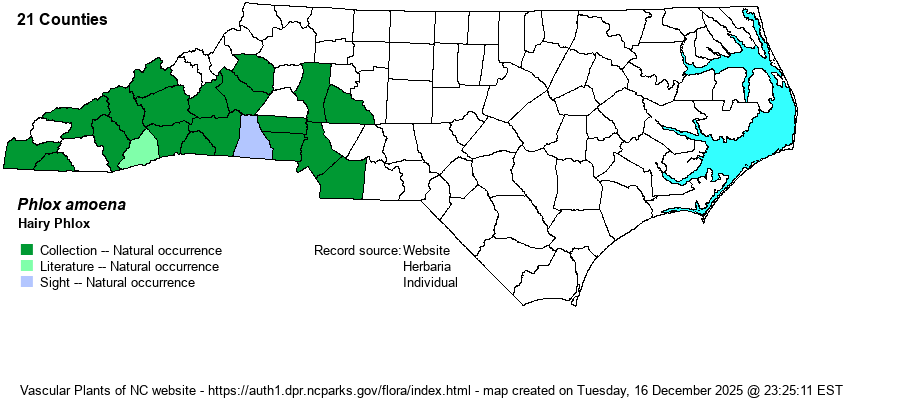| Author | Sims | |
| Distribution | Occurs in the southern half of the Mountains and the southwestern portion of the Piedmont, ranging north and east to Madison, Iredell, and Union counties.
This is a Southern species, ranging north only to southern KY and western NC, south to northern FL and barely to MS.
| |
| Abundance | Uncommon to locally fairly common in low elevations of the Mountains; generally uncommon in the southwestern Piedmont, becoming rare in the eastern part of the range. | |
| Habitat | This is a Phlox of dry places, usually in partial shade. It grows best on roadbanks and upland/dry woodland borders, but also is found in open woods. | |
| Phenology | Blooms from April to June, and fruits from June to July. | |
| Identification | This is one of the shorter species in the genus, generally reaching only about 8 inches tall, with erect to somewhat leaning stems. There may be a few stems from a common base, or a few short branches; the species often grows in dense clumps where it can be hard to count plants. This is a somewhat hairy species on the stems and leaves. There are only a few pairs of opposite leaves on each stem, the blades being narrowly elliptic to oblong to almost linear, only about 1-inch long and barely 1/6-inch wide, generally sessile, mainly ascending, and with entire margins. From the tips of the branches and stems are a few rose-colored flowers, each with a long and narrow tube and 5 flaring lobes (as in most species in the genus). Each flower is about 3/4-inch across. As with most other Phlox species, the key in identifying species is usually by leaf characters. This is not hard to find in dry wooded margins in some of the counties along the SC state line near the Blue Ridge Escarpment; when driving along wooded roads, keep an eye out for rose-pink flowers on low-growing plants. | |
| Taxonomic Comments | None
| |
| Other Common Name(s) | Chalice Phlox | |
| State Rank | S3? [S3] | |
| Global Rank | G4 | |
| State Status | | |
| US Status | | |
| USACE-agcp | | |
| USACE-emp | | |

